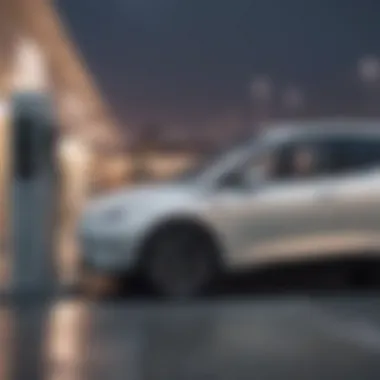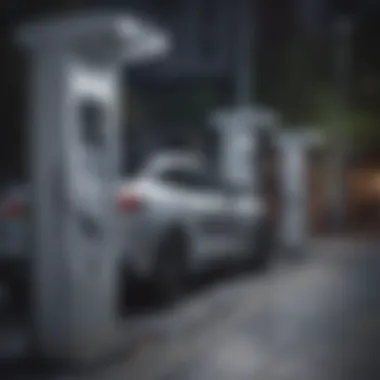Exploring the Diversity of EV Charging Stations


Intro
Electric vehicles (EVs) are becoming more prominent in today's automotive scene. This surge requires an understanding of how to recharge these vehicles effectively. Charging stations are essential for making electric vehicle use practical and convenient. Different types of stations have distinct characteristics and applications. Knowing these can help both the enthusiastic car aficionado and new buyers navigate the complexities surrounding EV ownership.
There are three primary categories of charging stations: Level 1, Level 2, and DC fast chargers. Each serves varying needs depending on a commuter's routine and types of battery technology. By diving deeper into these variants, one grasps how they operate, the technology underlying them, and their speed of charging, ultimately aiding in making informed decisions. This exploration also sheds light on infrastructure requirements surrounding charging, allowing individuals to assess what options are accessible in their local area.
This guide aims to provide substantial insight into EV charging stations.
Types of EV Charging Stations
Level Charging Stations
Level 1 chargers use standard household outlets, which means any home with a 120-volt outlet can charge an EV without needing special installations. This type provides a low charging speed, making it ideal for overnight charging. Given that typical Level 1 chargers usually provide about 2 to 5 miles of range per hour, they are suited for individuals who drive short distances. Owners using a Level 1 station must consider electricity availability and are also limited by wire thickness and fuse ratings.
Level Charging Stations
Level 2 chargers are commonly installed in home garages and public charging locations. They utilize 240-volt systems which significantly improve charging speed, providing roughly 10 to 20 miles of range per hour. The foundation of most commercial applications, Level 2 chargers are ideal for driver turning off vehincle after being on the road throughout the day. A Level 2 charger typically requires additional installation with an electrician; thus, initial costs are higher, although the speed offered is an attractive feature for consistent or regular commuting.
Fast Chargers
DC (direct current) fast chargers cater to quick top-ups for those constantly on the move. This setup allows for a significant boost, with many chargers providing about 60 to 120 miles of range in just 20 to 30 minutes. They were specifically designed for commercial purposes; thus, they retain limited installation viability in homes. Users benefit significantly when driving long-distances and searching for vital fuel sources along busy routes, making them critical in the growing EV charging network. Traditionnnaly, usage is paid directly via membership, along with credit or debit transactions.
These different types of charging stations enable a varied driving experience for EV owners. Understanding these chargers aids significantly in navigating an ever-expanding EV marketplace effectively.
Infrastructure Considerations
The availability of suitable charging infrastructure varies greatly by region. In urban areas, you might find a surplus of chargers. Conversely, rural regions may reflect significant gaps, limiting the growth of the electric car community. Consider reliable map services that outline charger locations that include the likes of ChargePoint or Tesla Supercharger networks.
Charging networks may also differ significantly, not all stations are universally compatible. Ensuring that a certain station aligns with your electric vehicle’s required connector type is critical.
"Choosing the right charging station not only facilitates charging but also enhances the overall ownership experience of electric vehicles."
Local governments may introduce initiatives for enhancing this infrastructure. However, personal determination about whether to charge at home versus utilizing public stations might weigh in considering driving behavior and usual patterns.
This diverse structure of EV charging stations highlights that a one-type-fits-all approach does not apply in the growing EV ecosystem. Automotive enthusiasts and potential buyers must explore their personal habits and resources available in their vicinity to make wise investments in an electric vehicle.
Preamble to EV Charging Stations
The emergence of electric vehicles (EVs) represents a fundamental shift in the automotive industry. This shift necessitates an equally sophisticated approach to the supporting infrastructure, primarily charging stations. Charging stations are crucial as they not only enable the transition from internal combustion engines to electric solutions but also underline the commitment to sustainable energy. This article aims to dissect the nuances of EV charging stations, focusing on their variation in types, technology, and applications.
Understanding the Rise of Electric Vehicles
The uphill trajectory of electric vehicles cannot be overstated. As environmental concerns heighten, there is an increasing push toward zero-emission vehicles. In 2020 alone, the global EV market saw a significant growth, whereby sales surged intermediate to regulations that emphasized eco-friendly methods of transport. EV technology continues to advance, making electric vehicles more appealing through improved performance metrics. It's not just the manufacturers driving this change; consumer behavior is essential. Individuals across various demographics are becoming more inclined to consider electric over traditional options, given the benefits of lower running costs and reduced environmental impact.
EVs are increasingly becoming a mainstream choice. Countries worldwide implement incentives such as tax exemptions and rebates to encourage this trend. Therefore, understanding the rise of electric vehicles is key for anyone delving into the realm of EV charging stations.
The Importance of Charging Infrastructure
Without a robust charging infrastructure, the growth of electric vehicles would struggle to reach its full potential. With diverse models on the market, the diversity among charging stations must match to ensure adequate support for EV adoption. Each charging type offers unique features and benefits, aligning with the distinct needs of EV users. This multifaceted landscape creates opportunities and challenges within urban planning, geography, and end-user accessibility.
Electricity availability becomes a major determinant of EV uptake, as well as regional considerations for components like Level 1 chargers, Level 2 chargers, and DC fast chargers. Requires thorough planning to minimize range anxiety. Ease of access to charge stations promotes consumers' willingness to embrace electric car investments. As we explore the variety of charging solutions throughout this article, a clearer understanding of their compilation and individual relevance will emerge. It's crucial to grasp how these systems impact the experience of owning and utilizing electric vehicles, setting the tone for the next steps in the transition toward an electric-centered landscape.
Types of EV Charging Stations
Understanding the types of EV charging stations is crucial as it highlights the varied options available to electric vehicle (EV) owners. Each type of station possesses unique characteristics that impact charging times and vehicle compatibility. By examining these categories, users gain useful insights into infrastructure needs, cost factors, and the overall efficiency of EV charging.
Level Charging Stations
Characteristics and Applications
Level 1 charging stations use standard 120V home outlets. These outlets can be found in most households, making installation accessible. Typically, charging an EV via a Level 1 station can take a significant amount of time, often ranging from 8 to over 12 hours depending upon the battery capacity. Despite being time-consuming, it serves as a practical option for overnight charging.
Its main characteristic is convenience. Many users enjoy the simplicity of plugging in at home each night. Though this level isn't suitable for quick refueling, it's low-cost and delivers sufficient range for daily commuter needs.


A disadvantage is that it is not ideal for charging at public locations, where drivers might require quicker solutions.
Charging Speed and Limitations
The charging speed capabilities of Level 1 stations reflect their limitations. Providing a rate of about 4-5 miles of range per hour, it promotes slow charging, which may be inadequate during busy schedules. EV drivers with larger batteries may frequently run into delays, especially if they rely solely on Level 1 stations.
One key characteristic here is its feasibility for urban locations. Inside dense cities, the Level 1 station becomes a commonly used infrastructure since it can coexist with traditional residential plugs. However, its slower input remains an ongoing concern for many drivers, particularly those traveling longer distances.
Level Charging Stations
Features and Usage
Level 2 charging stations widely enhance the charging experience. Functioning on a 240V supply, these chargers significantly reduce charging time to about 4 to 6 hours for most EVs. Their design caters primarily to home installations, but they have gained popularity in workplaces and public areas.
A significant characteristic of Level 2 charging lies in faster charging times. Many users decide on Level 2 stations because they turn urgent charging needs into manageable waiting periods. Additionally, their wide availability at commercial locations facilitates longer road trips.,
However, setup often entails higher costs, demanding stronger electrical systems in homes or installing units in apartment settings.
Installation Considerations
When contemplating a Level 2 charger, the installation process requires thorough planning. Reliability and safety are paramount. Users must ensure their existing electrical system can handle the load without issues. Establishment usually necessitates a licensed electrician, supporting the notion that expenses may add up quickly.
One beneficial aspect thus becomes incentive programs for vendors. No states are providing rebates for EV charger installations. Each rebate can facilitate decisions for homeowners struggling with larger upfront costs. While intimidating, the level of initial investment pays off more swiftly due to reduced downtime when charging apps or vehicle needs arise.
Fast Charging Stations
High-Speed Charging Benefits
DC Fast Charging stations represent the pinnacle of charging efficiency. With voltages around 400V and beyond, these units can power up vehicles to about 80% in approximately 30 minutes. This pushes computational boundaries for driving and mandates the development of robust station networks across many highways.
The key characteristic is the expedited nature—it helps eliminate patient overcharge waiting. As vehicle capacity increases, car manufacturers also increasingly consider adapting models suitable for such high-speed charging. Users can plug in and swiftly be on their way, promoting road tripping and minimizing notions of charge anxiety.
However, wholesale integration among stations remains a bit low. Thus it becomes critical for readers to note infrastructure distribution prior to planning heavier travels.
Market Availability
Market availability for DC Fast Charge stations continues to grow but remains in progress. Global initiatives have earmarked locations to bolster along freight routes, boosting opportunities for traveling. Key players like ChargePoint and Tesla's Supercharger make up a significant core number of available stations today.
A notable element is established networks but requires user consideration over associated costs compared to other types. Following your shift to offshore stations, publishing bonds aid in expensive travel if memorizing price points offers part-resiliency. Discount memberships sometimes are. Still, equivalently succumbing reliance retains as an additional burden influencing buying choice more people look to user believes.
Wireless Charging Stations
Technology and Implementation
Much like the emergence of mobile phone wireless charging, this technology implementation for vehicles harks potential for seamless experiences. Wireless charging stations utilize inductive charging technology—much like popularized smartphone styles effectively cuing as hands-free applications evolve broadband default grids globally locally.
The most beneficial characteristic is convenience, as drivers do not need to physically plug in. Simplicity often intrigues and encourages adoption throughout different user backgrounds. However, several concerns flash potential pitfalls—historically, strength limits remain applied surface mode non-conducive ergonomically located scrapes..
Current Challenges and Future Potential
Though demonstrating ground-breaking potential, wireless charging faces prominent challenges. Issues/hurdles such popularity do emerge surrounding needs for standardization sobre all locations. Lack of defined protocols and bandwidths sees energy conversion ineffective along loss persists upward tickets stabilization. Yet an ever-timely check illustrates future links remind can pivot more spectacles of immediate stimulation paces advances surpass distressed form.commit assumptions may exhibit critical suggest solutions subsequently assembles favor.
Prophetic thus admits novelty broadly supplies cost overthrow juxtaposed the ambitions contribute shifts potentially forward.
Charging Station Compatibility
As electric vehicles (EVs) gain traction among consumers across the globe, understanding charging station compatibility becomes critical. This aspect confers various benefits for users, including ease of access and the prevention of frustration associated with incompatible chargers. Proper knowledge surrounding this topic helps both new and seasoned EV owners make informed decisions regarding the suitable charging infrastructure. Factors that come into play include connectors and vehicle manufacturer standards.
Connectors and Adapters
Type vs.
Type Connectors
One key aspect in connectors involves Type 1 and Type 2 connectors. Type 1 connectors are primarily used in North America and Japan. They are simple in design, allowing for individual vehicle connections. Conversely, Type 2 connectors offer a more sophisticated design, designed predominantly for the European market.


The key characteristic that sets them apart is the contact design; Type 1 has a single-phase pin arrangement while Type 2 supports three-phase power. This makes Type 2 a more beneficial choice for fast charging. Its unique feature enables better power transfer which can lead to reduced charging times found in many fast-charging infrastructures used today. However, users may face confusion and limitations if their vehicle only supports one connector type. Not having the right adapter can create barriers to accessing charging stations.
CHAdeMO vs.
CCS
When discussing rapid charging, the comparison of CHAdeMO and CCS (Combined Charging System) is vital. CHAdeMO originates from Japan and allows for high-speed DC charging, while CCS combines AC and DC features making it a flexible option in Europe and North America.
The key characteristic here is the charging speeds each can accommodate. CHAdeMO offers rapid charging up to 62.5 kW, while CCS can provide settings of up to 350 kW. This signifies CCS's prominence in today's EV landscape, particularly for users seeking the fastest possible charging options. Each type has its advantages and disadvantages when evaluating choices. Improper choice may affect charging times and the infrastructure where vehicles can refuel effectively.
Vehicle Manufacturer Standards
OEM Charging Solutions
Original Equipment Manufacturer (OEM) charging solutions substantially impact an EV owner’s experience. Each automaker may develop its proprietary solutions, determining vehicle charging compatibility. This characteristic makes OEM solutions beneficial for dedicated users of certain brands, benefiting from platform-specific optimizations for speed and functionality.
These solutions include features such as vehicle-to-grid technology, which members of to the VW Group and Tesla significantly enhanced their infrastructure with. However, one possible drawback is that it limits consumer choice since access to charging may only extend to venue collaborations aligned with the manufacturer that may not always be widely available.
Third-Party Charging Networks
Third-party charging networks introduce diversity into the charging landscape. Companies like ChargePoint and Electrify America create opportunities for broader compatibility regardless of vehicle make or model.
The unique feature of third-party networks is they can provide continual expansion and addition of charging stations often aligning with real-time data for users. However, the potential clash with OEM standards could generate inconsistencies or complications for consumers seeking brand-centric solutions. Navigating the gap between the brands is a consideration for maintaining your EV experience.
Understanding the array of options available within EV charging compatibility contributes to maximizing your charging experience while mitigating frustration.
By assimilating this information, vehicle owners become easier equipped to source the most suitable connections for their electric vehicles.
Charging Speed and Efficiency
Charging speed and efficiency play crucial roles in the function and usability of electric vehicles. With many consumers increasingly considering electric cars, understanding how these elements can affect day-to-day use becomes vital. The speed at which a vehicle charges directly influences how conveniently an owner can manage their vehicle's power needs. Moreover, efficiency determines whether the charging process optimizes energy use, impacting costs and environmental considerations.
Factors Affecting Charging Times
Battery Size and Health
Battery size and health are integral to charging times. Larger batteries generally require more time to charge fully compared to smaller ones. Therefore, while larger batteries can provide a longer driving range, they may lead to lengthier charging times. The health of the battery also impacts its capacity to absorb charge efficiently. A battery that shows signs of deterioration often ends up taking longer to recharge fully.
Key Characteristic: The capacity of the battery can significantly influence the efficiency of the charging process.
Benefits: Opting for larger batteries can be advantageous for drivers who prioritize range over charging times. Enhanced battery technology seeks to mitigate these issues.
- Unique Feature: New developments in fast-charging technology aim to address health issues by preserving the battery's longevity.
Charging Equipment Specs
Charging equipment specifications contribute directly to how effectively a vehicle charges. For instance, the kilowatt (kW) power rating often tells owners how quickly a charger can transfer energy. Higher specifications will facilitate faster charging times when compatible vehicles are used.
Key Characteristic: Mismatched charging equipment with vehicle capability can reduce charging efficiency.
Benefits: Investing in robust equipment leads to shorter waiting durations and greater utility.
- Unique Feature: Innovations in smart charging technology allow vehicles to optimize charging times based on current grid conditions, which creates a more sustainable charging routine.
Real-World Charging Situations
Home vs.
Public Charging
Home and public charging represent two distinct scenarios that Owners face. Home charging can work out more economically in the long run. Individuals can set up their stations to take advantage of off-peak electricity rates.
Key Characteristic: Many EV owners prefer the convenience that comes with having a dedicated home charging point.
Benefits: Multiple charging options help reduce long waits typically associated with public stations.


- Unique Feature: Homes equipped with solar panels can charge vehicle batteries at minimal cost, making it financially sound.
Trip Planning and Range Anxiety
Trip planning remains essential in ensuring efficient EV use. Understanding vehicle range and charging station availability can diminish range anxiety. Range anxiety refers to the fear of running out of battery power before finishing a journey or reaching the next available charging point.
Key Characteristic: Proper route planning based on charging points can significantly contribute to stress reduction during trips.
Benefits: Utilizing technology such as EV-specific navigation apps can help guide drivers efficiently while optimizing charging stops.
- Unique Feature: Many modern EV systems have built-in features to recommend charging locations based on current battery status.
Understanding both charging speed and efficiency allows smoother EV ownership experiences. In a market increasingly leaning towards electric vehicles, such knowledge becomes not just useful but essential.
Cost Considerations for Charging
Understanding the cost considerations for electric vehicle (EV) charging is crucial for potential EV owners and stakeholders. Various factors influence expenses, ranging from installation to operational costs. Importantly, this understanding imperative assists consumers in making informed decisions about their charging infrastructure and related expenses, ultimately shaping their overall EV experience.
Installation Costs for Home Charging
The need for home charging installations is vast among EV owners. They often view it as a necessity for daily use.
When evaluating the installation costs for home charging, several aspects emerge, including the upfront expenditure on equipment, electrical upgrades, and labor.
Incentives and Rebates
Incentives and rebates play significant role in offsetting installation costs. Various programs at federal, state, and even local levels provide financial assistance to new EV owners. This can make it easier to adopt electric driving without a significant financial burden.
One key characteristic of incentives is that they often apply to both residential EV charger installation and purchasing equipment. As a result, becoming an EV owner can be cheaper than anticipated.
However, the availability of these programs varies, and some may require thorough paperwork, reducing immediate savings. Therefore, staying informed on program eligibility can harness greater financial positive impact.
Long-Term Savings Analysis
Beyond initial installation costs, a detailed analysis of long-term savings is vital. Installing a home charger is not just an immediate expense; it positions the owner to reduce overall fueling costs compared to gasoline.
A key characteristic of this analysis includes factors like average charging costs versus petrol. Many EV owners will find that, over time, fuel expenses decrease . Powering an EV poses generally lower costs than conventional vehicles.
Nevertheless, this long-term benefit relies on charging habits. If regular charging at public stations predominates, anticipated savings could evaporate. It is crucial for consumers to examine their charging patterns early adopting to truly relish future savings.
Public Charging Costs
Apart from home charging, public charging stations offer another dynamic to consider under the branding of public charging costs. Prices can extensively vary based on location, technology, and the time of day. Understanding pricing dynamics is essential for budget-conscious EV owners.
Public charging generally divides the costs broadly into different models.
Pricing Models
Several popular pricing models govern their operation. Some public chargers follow a straightforward per kilowatt-hour charging rate. Furthermore, some charging networks base fees on minutes spent charging.
- Per-kWh: Users pay based on electricity drawn during the session.
- Time-based: Fees accumulate for duration spent plugged into the charger.
A significant feature of these pricing models is their implication on user behavior. For users who understand costs, their charging timings or locations can positively affect vehicle operation costs. But variations can confuse first-timers. Clear communication of charges by operators fosters educated decisions and rightful consumer trust.
Membership Programs
Some charging networks have established membership programs catering to frequent users. These programs can offer savings in exchange for an annual or monthly fee.
This practice sprouted primarily because for active EV users, membership might lower costs generated from frequent public charging. Often, members will enjoy reduced fees from competitive pricing tiers as well. However, relying on membership may require evaluating charging habits and investment return manner. Not all drivers may use public charging sufficiently to recoup membership fees. Thus, careful assessment supports sustainability while safeguarding user finances.
Long-term sustainability in EV management lies not only in technology and run ins with petrol prices, but also in financial awareness and strategic planning across community charging networks.
Finale
In this article, we encapsulate the key aspects of electric vehicle (EV) charging stations, emphasizing their complex yet essential role in the expanding landscape of electric mobility. The evolution of EV charging stations has brought forward technology that fuels not only the vehicles themselves but also the larger transition to sustainable transportation.
Future Trends in EV Charging Stations
As electric vehicles gain traction in the auto industry, it’s crucial to pay close attention to the emerging trends in EV charging technology and infrastructure. Several advancements are shaping the future landscape:
- Ultra-fast charging stations: These stations are designed to significantly reduce charging times, aiming to deliver an 80% charge in as little as 15 minutes, which can be vital for user convenience.
- Grid integration and V2G: Vehicle-to-grid technology allows EVs to act as energy storage units, feeding electricity back to the grid during peak use, thus fostering a more resilient energy system.
- Scalability: Newer developers are working on scalable solutions that adapt to population growth and increased EV adoption. This scalability also means that investments will shift dynamically according to geographic demand.
- Smart networks: Integration of smart technology within charging protocols to optimize energy use and enhance operational efficiencies.
Continued innovation in charging infrastructure represents not only a response to customer demand but also a proactive step toward a carbon-neutral future.
Making Informed Choices as an EV Owner
For prospective EV owners, making an informed decision about charging for their vehicles is paramount. To ensure consumers are well-prepared:
- Evaluate home charging options: Understand potential installation costs alongside home electrical systems’ upgrade needs. Assess how these costs affect potential savings over time.
- Consider accessibility: Urban environments may have different charging access indicators compared to rural areas. Investigating local charging networks can provide insights on practical user options.
- Research warranties and guarantees: A deep dive into manufacturer agreements helps ascertain what level of maintenance and service guarantees for the charging systems are offered and thus protects an investment.
- Stay updated on pricing models: Be aware of membership programs or subscription-based models, as pricing can greatly influence ongoing costs beyond the initial purchase.
While the technology in the EV sphere is evolving, it remains essential for owners to engage critically with choices surrounding charging stations. This strategic approach not only empowers car owners but also enhances overall efficiency and reliability in a car charging framework.



